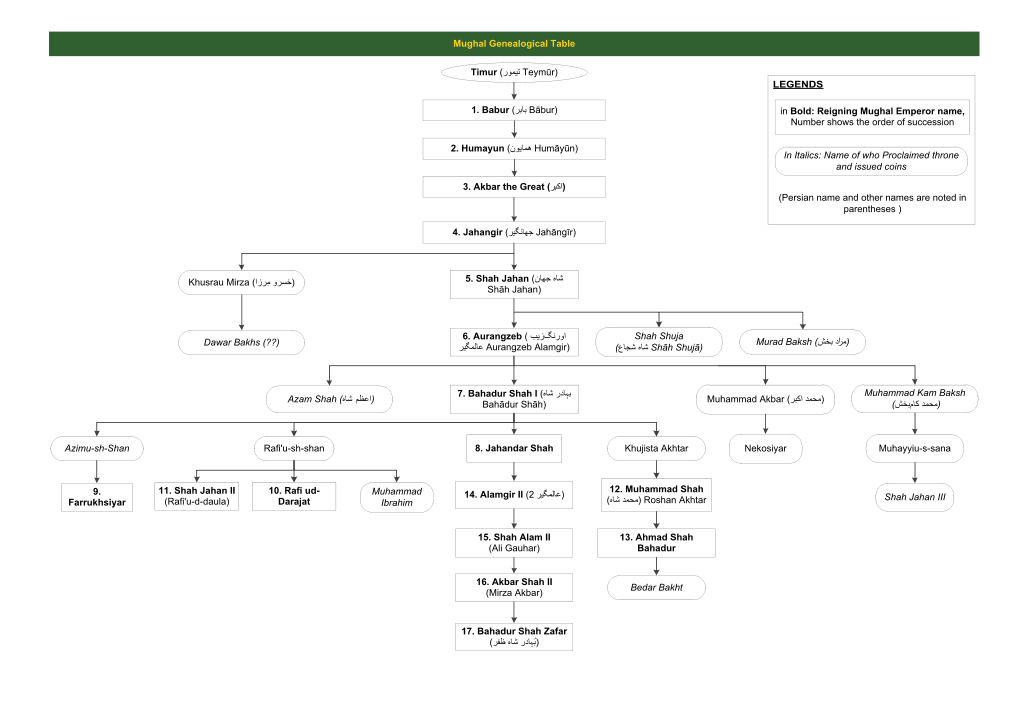Mughal Empire
The Mughal Empire was a powerful and significant dynasty that ruled over the Indian subcontinent from the early 16th to the mid-18th century. Founded by Emperor Babur in 1526, the empire’s zenith was during the reign of Emperor Akbar, Jahangir, and Shah Jahan. Known for its grandeur, art, and cultural achievements, the Mughal Empire left a profound impact on India’s history, blending Persian, Indian, and Central Asian influences.
Mughal Empire – Overview
| Name | Mughal Dynasty Or Mughal Empire |
|---|---|
| Period | 1526- 1857 AD. |
| Language | Persian (Official Language), Zaban e Urdu e Mua’lla (the language of the ruling classes, later given official status), Arabic (for religious ceremonies), Chagatai Turkic |
| Religion | Sunni Islam (Hanafi) (1526–1857), Din-i Ilahi (1582–1605) |
| Capital | Agra (1526–1540; 1555–1571; 1598–1648)Fatehpur Sikri (1571–1585)Lahore (May 1586 – 1598)Shahjahanabad, Delhi (1648–1857) |
Mughal Empire History
The Mughal Empire, a remarkable chapter in India’s history, spanned from 1526 to 1858, leaving an indelible mark on the Indian subcontinent. Founded by Babur, a Central Asian conqueror, the empire flourished under the reigns of illustrious emperors such as Akbar, Jahangir, and Shah Jahan. Renowned for its grandeur, opulence, and cultural brilliance, the Mughal Empire witnessed a Golden Age marked by administrative reforms, economic prosperity, and religious tolerance. From iconic architectural marvels like the Taj Mahal to military prowess, the empire’s legacy continues to shape India’s language, art, architecture, and political history. However, the empire’s decline in the late 17th century, coupled with the advent of European colonialism, ultimately led to its dissolution by the British in 1858 after the Indian Rebellion of 1857.
| Aspect | Description |
|---|---|
| Founding (1526) | Babur established the Mughal Empire after defeating the Sultan of Delhi in the Battle of Panipat. |
| Golden Age (16th-17th centuries) | Under Akbar, the empire reached its zenith with administrative reforms, economic prosperity, and religious tolerance. |
| Architectural Marvels | The Mughal emperors commissioned iconic structures like the Taj Mahal and the Red Fort. |
| Military Power | The empire expanded through military conquest, becoming one of the wealthiest and most powerful globally. |
| Decline (late 17th century) | Weak leadership, economic decline, and European colonialism contributed to the empire’s downfall. |
| Dissolution (1858) | The British dissolved the Mughal Empire after suppressing the Indian Rebellion of 1857. |
| Cultural Legacy | The Mughal Empire’s influence is seen in India’s language, art, architecture, cuisine, and history. |
Mughal Empire Tree

Mughal Empire Rulers’ Name
| Emperor | Reign |
|---|---|
| Babur | 1526–1530 |
| Humayun | 1530–1540 |
| Suri Dynasty | 1540-1555 |
| Humayun | 1555–1556 |
| Akbar | 1556–1605 |
| Jahangir | 1605–1627 |
| Shah Jahan | 1627–1658 |
| Aurangzeb | 1658–1707 |
| Bahadur Shah I (also known as Muazzam/Shah Alam) | 1707–1712 |
| Jahandar Shah | 1712–1713 |
| Furrukhsiyar | 1713–1719 |
| Rafi UL-Darjat | 1719 |
| Rafi Ud-Daulat | 1719 |
| Nikusiyar | 1719 |
| Muhammad Ibrahim | 1720 |
| Muhammad Shah (also called Rangeela) | 1719–1720; 1720–1748 |
| Ahmad Shah Bahadur | 1748–54 |
| Alamgir II | 1754–1759 |
| Shah Jahan III | 1759 |
| Shah Alam II | 1759–1806 |
| Akbar Shah II | 1806–1837 |
| Bahadur ShahII | 1837–1857 |
Popular Mughal Kings
Babur
Babur, the founder of the Mughal Empire, was a charismatic and tenacious ruler who left an indelible mark on India’s history. Born in 1483 in present-day Uzbekistan, Babur descended from the lineage of Genghis Khan and Timur. His ambition to establish his empire led him to invade India in 1526, defeating the Sultan of Delhi in the pivotal Battle of Panipat. Despite facing numerous challenges, Babur’s military prowess and strategic acumen prevailed, establishing the foundation for the Mughal Empire. Beyond being a skilled conqueror, Babur was a gifted poet and diarist, leaving behind invaluable accounts of his life and the era he shaped.
Humayun
Humayun, the second Mughal Emperor, was a complex and resilient figure in Indian history. Born in 1508 to Babur, he inherited the throne after his father’s death in 1530. Despite facing initial challenges and rebellions, Humayun displayed his determination and leadership skills in restoring and expanding the Mughal Empire. His reign was marked by both victories and setbacks, including temporary exile to Persia after being defeated by Sher Shah Suri. However, Humayun’s eventual return to power in 1555 demonstrated his perseverance. He laid the foundation for the flourishing Mughal Empire, which his son Akbar would later elevate to its golden age of prosperity and cultural brilliance.
Akbar
Akbar, known as Akbar the Great, was the third Mughal Emperor and one of the most illustrious rulers in Indian history. Born in 1542, he ascended to the throne at the age of 13 after the untimely death of his father, Humayun. Throughout his reign from 1556 to 1605, Akbar displayed extraordinary political acumen and military prowess, expanding the Mughal Empire to encompass a vast territory through strategic alliances and military campaigns. Renowned for his policy of religious tolerance and promoting a syncretic culture, Akbar encouraged dialogue between various faiths, leading to the development of a distinctive Mughal architecture and art. His reign is often regarded as the “Golden Age” of the Mughal Empire, characterized by administrative reforms, economic prosperity, and a flourishing cultural renaissance.
Jahangir
Jahangir, the fourth Mughal Emperor, was a fascinating and complex ruler who left a significant impact on the Mughal Empire. Born in 1569, he ascended to the throne in 1605 after the death of his father, Akbar. Jahangir’s reign was marked by a blend of military successes and a deep interest in arts, culture, and literature. He was a patron of the arts and welcomed artists, poets, and scholars into his court, fostering a cultural renaissance. However, his reign also witnessed challenges, including the rebellion of his son, Khurram (who later became Shah Jahan). Jahangir’s legacy lies in his cultural contributions and his role as a connoisseur of beauty and fine arts.
Shah Jahan
Shah Jahan, the fifth Mughal Emperor, is celebrated for his profound contributions to India’s architectural and cultural heritage. Born in 1592, he ascended to the throne in 1628 after the demise of his father, Jahangir. Shah Jahan’s reign is often referred to as the pinnacle of Mughal architecture, with iconic monuments such as the Taj Mahal, a symbol of eternal love, and the Red Fort in Delhi, showcasing his grand vision and artistic sensibility.
Aurangzeb
Aurangzeb, the sixth Mughal Emperor, is a figure both revered and controversial in Indian history. Born in 1618, he ascended to the throne in 1658 after imprisoning his father, Shah Jahan. Aurangzeb’s rule was characterized by his strict adherence to orthodox Sunni Islam, leading to a series of policies that alienated many, including non-Muslims. He expanded the Mughal Empire to its greatest territorial extent through military conquests but faced constant resistance from various regional powers.
Aurangzeb’s religious policies, heavy taxation, and prolonged military campaigns strained the empire’s resources and led to discontent among the populace. His rule has been a subject of debate among historians, with some criticizing his policies, while others appreciate his military acumen and administrative reforms. Upon his death in 1707, the Mughal Empire began to decline, and his legacy remains a complex and contentious aspect of India’s history.
Mughal Empire – FAQs
Ans. The Mughal Empire was established in 1526 by Babur, a Central Asian conqueror, after his victory in the Battle of Panipat against the Sultan of Delhi.
Ans. Akbar the Great, the third Mughal Emperor, is renowned for his policy of religious tolerance. He encouraged dialogue between various faiths and sought to promote harmony and understanding among his subjects.
Ans. The Taj Mahal, a magnificent white marble mausoleum in Agra, was built by Emperor Shah Jahan as a memorial for his beloved wife, Mumtaz Mahal. It is considered one of the most beautiful and iconic symbols of love in the world.
Ans. The decline of the Mughal Empire can be attributed to various factors, including weak leadership, succession struggles among the Mughal princes, economic troubles, and the rise of regional powers and European colonial influence. These challenges gradually weakened the empire, leading to its eventual decline and the emergence of British colonial rule in India.

The most comprehensive online preparation portal for MBA, Banking and Government exams. Explore a range of mock tests and study material at www.oliveboard.in
